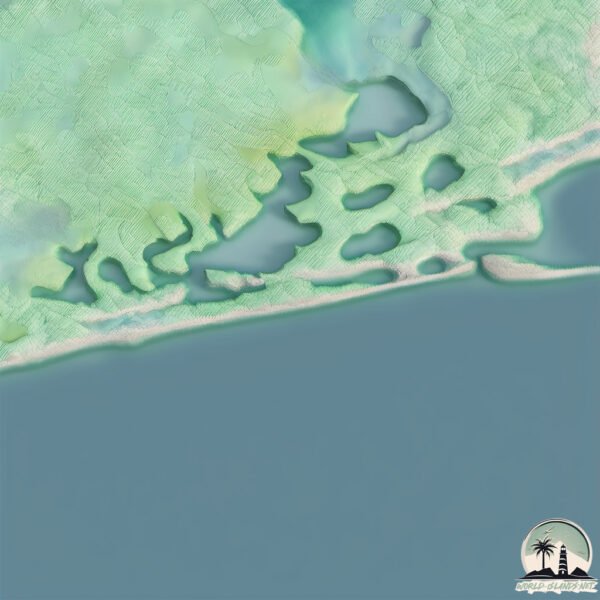Perdido Key

Welcome to Perdido Key, a Temperate island in the Gulf of Mexico, part of the majestic Atlantic Ocean. This guide offers a comprehensive overview of what makes Perdido Key unique – from its geography and climate to its population, infrastructure, and beyond. Dive into the details:
- Geography and Size: Explore the island’s size and location.
- Climate and Weather: Weather patterns and temperature.
- Topography and Nature: Uncover the natural wonders of the island.
- Infrastructure and Travelling: Insights on reaching, staying, and making the most of your visit.
- News and Headlines: Latest News.
Geography and size of Perdido Key
Size: 13.2 km²
Coastline: 60.6 km
Ocean: Atlantic Ocean
Sea: Gulf of Mexico
Continent: North America
Perdido Key is a Medium Island spanning 13 km² with a coastline of 61 km.
Archipel: –
Tectonic Plate: North America – Covers North America and parts of the Atlantic and Arctic Oceans, characterized by diverse geological features and varying levels of seismic activity.
The geographic heart of the island is pinpointed at these coordinates:
Latitude: 30.29925945 / Longitude: -87.43556853
Climate and weather of Perdido Key
Climate Zone: Temperate
Climate Details: Humid Subtropical Climate
Temperature: Hot Summer
Climate Characteristics: With continuous rainfall and hot summers, this climate is common in some coastal regions, supporting diverse vegetation.
Topography and nature of Perdido Key
Timezone: UTC-06:00
Timezone places: America/Chicago
Max. Elevation: 8 m
Mean Elevation: 3 m
Vegetation: Evergreen Needleleaf Forest
Tree Coverage: 75%
The mean elevation is 3 m. The highest elevation on the island reaches approximately 8 meters above sea level. The island is characterized by Plains: Flat, low-lying lands characterized by a maximum elevation of up to 200 meters. On islands, plains are typically coastal lowlands or central flat areas.
Dominating Vegetation: Evergreen Needleleaf Forest
Dominated by evergreen coniferous trees such as pines and firs, which retain their needle-like leaves throughout the year. These forests are often found in cooler climates. Perdido Key has a tree cover of 75 %.
Vegetation: 10 vegetation zones – Very Highly Diverse Island
Islands in this range are ecological powerhouses, showcasing a wide array of vegetation zones. Each zone, from lush rainforests to arid scrublands, coastal mangroves to mountainous regions, contributes to a complex and interdependent ecosystem. These islands are often hotspots of biodiversity, supporting numerous species and intricate ecological processes.
Infrastructure and Travelling to Perdido Key
Does the island have a public airport? no.
There is no public and scheduled airport on Perdido Key. The nearest airport is Pensacola International Airport, located 21 km away.
Does the island have a major port? no.
There are no major ports on Perdido Key. The closest major port is PENSACOLA, approximately 13 km away.
The mean population of Perdido Key is 133 per km². Perdido Key is Moderately Inhabited. The island belongs to United States of America.
Continuing your journey, Blakeley is the next notable island, situated merely km away.
Perdido Key Beach is a hidden gem on the coast of Florida It is located on a barrier island between



United States of America is classified as Developed region: G7: Group of Seven – Major advanced economies, including Canada, France, Germany, Italy, Japan, the United Kingdom, and the United States. The level of income is High income: OECD.
News – Latest Updates and Headlines from Perdido Key
Stay informed with the most recent news and important headlines from Perdido Key. Here’s a roundup of the latest developments.
- This Stunning Florida Barrier Island Could Easily Pass For the Caribbean - Southern Livingon 29 November 2025
This Stunning Florida Barrier Island Could Easily Pass For the Caribbean Southern Living
- County commissioners eye take over of Johnson Beach, Perdido Key State Park - Pensacola News Journalon 20 November 2025
County commissioners eye take over of Johnson Beach, Perdido Key State Park Pensacola News Journal
- Islands to Boat to on Alabama's Beaches - Gulf Shores & Orange Beach Tourismon 1 September 2025
Islands to Boat to on Alabama's Beaches Gulf Shores & Orange Beach Tourism
- Coastal Dynamics Monitoring at Gulf Islands National Seashore, Mississippi and Florida: 2018-2024 - National Park Service (.gov)on 22 August 2025
Coastal Dynamics Monitoring at Gulf Islands National Seashore, Mississippi and Florida: 2018-2024 National Park Service (.gov)
- Restoring Alabama’s Lower Perdido Islands to Protect Wildlife and Coastal Communities - NOAA Fisheries (.gov)on 21 August 2025
Restoring Alabama’s Lower Perdido Islands to Protect Wildlife and Coastal Communities NOAA Fisheries (.gov)
- Lower Perdido Islands restoration supporting beach-nesting birds in Orange Beach - Gulf Coast Mediaon 31 July 2025
Lower Perdido Islands restoration supporting beach-nesting birds in Orange Beach Gulf Coast Media
- 8 Most Idyllic Small Towns on the Gulf Coast - WorldAtlason 26 June 2025
8 Most Idyllic Small Towns on the Gulf Coast WorldAtlas
- 19 Florida Beaches That Could Pass For The Caribbean - Southern Livingon 23 June 2025
19 Florida Beaches That Could Pass For The Caribbean Southern Living
- Annual Flyover Reveals a Changing Landscape at the Orange Beach Islands - Orange Beach Newson 4 June 2025
Annual Flyover Reveals a Changing Landscape at the Orange Beach Islands Orange Beach News
- Wilmington-area beaches among Southern Living's best beach towns in the South - Wilmington Star-Newson 8 April 2025
Wilmington-area beaches among Southern Living's best beach towns in the South Wilmington Star-News
Please note: The data used here has been primarily extracted from satellite readings. Deviations from exact values may occur, particularly regarding the height of elevations and population density. Land area and coastline measurements refer to average values at mean high tide.
